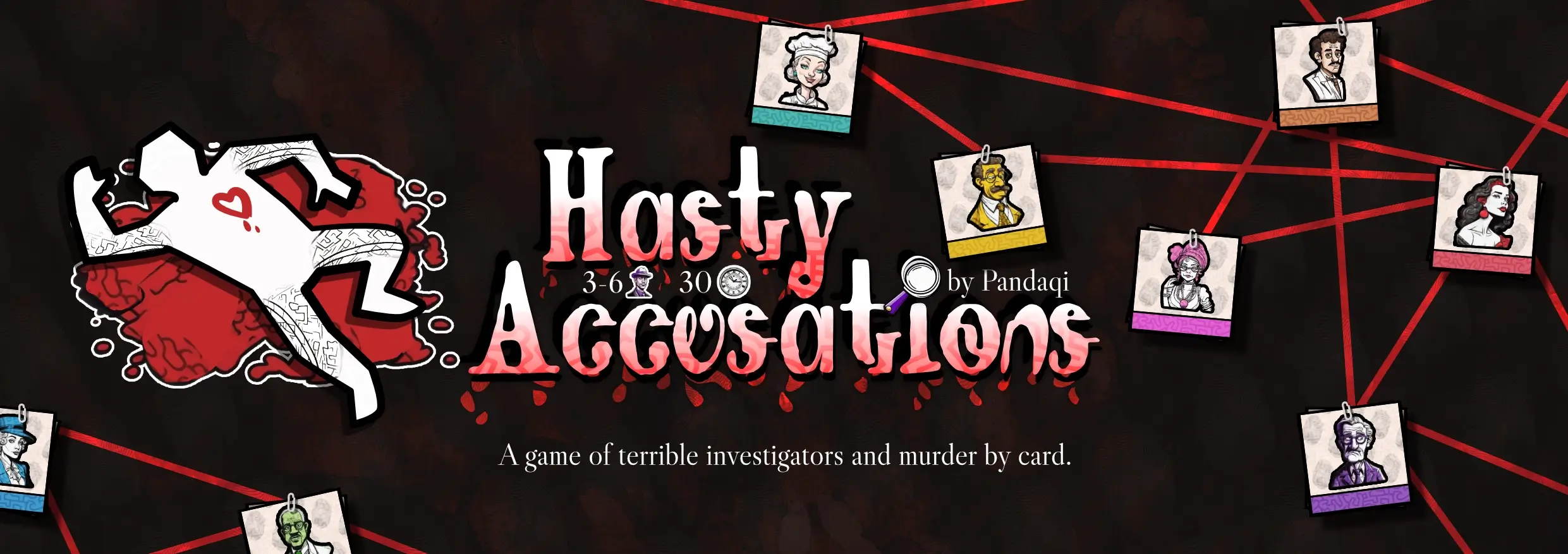Pick which card set you want from the website. For your first games, just pick the base set. As you gain experience, consider introducing more and more advanced cards.
Decide the number of suspects to use. It’s recommended to use at least 5 and more than the number of players.
Then,
- Place one row of faceup suspects on the table.
- Place the loupe token above a suspect in the middle of the row.
- Create a deck of suspect cards (that are in the game). Shuffle and deal each player 1: this is their secret suspect.
- Create a deck of playing cards, shuffle, and deal each player 4.
- Finally, create a row of 4 faceup cards next to the deck: the market.
Let’s start!

The game ends when only one player is left. They win!
Most treacherous player starts. Take clockwise turns until done.
Play as many cards from your hand as you want.
Each card is placed on the “evidence pile” below a suspect that is still alive. (Its tile is not turned facedown.)
- If you play a card faceup ( = open), you execute its action and move the loupe one step forward.
- If you play the card facedown, move the loupe one step backward.
If you play nothing, discard your whole hand, and the loupe moves forward one step.
Only move the loupe at the end of your turn, after playing all your cards and summing their movement. If there is no next step for the loupe, it wraps around to the other side. If this happened, execute a review now!

When a review triggers, whatever evidence pile has the most cards is evaluated. (If tied, the active player picks one of them to evaluate.)
From top to bottom, reveal each card and execute what it does.

Evaluation has three simple rules:
- If an action must be executed by a player, this is always the active player.
- If the corresponding suspect is murdered, turn the suspect tile facedown and stop revealing cards immediately.
- If the murdered suspect matches a player’s secret suspect, they must say so. They’re eliminated and discard their hand.
Discard all cards from the evaluated evidence pile.
Finally, all players fill up their hand. Starting with the active player, take clockwise turns drawing your hand back up to the hand limit (default = 4):
- Pick as many cards as needed from the market.
- Then refill the market from the deck, up to the current hand limit.
Next turn!
Cards always have a power. As stated, this triggers when revealed. This happens when played faceup or when a pile is evaluated during Review.
Some cards, however, show an icon in the top left.
- A means their action only triggers during review! (Not when played faceup in regular play.)
- A means their action does not trigger during review! (Only in regular play.)
See All Cards if you want a reference that displays and explains all cards in the game.
When dealing out secret suspects,
- Select random cards equal to the number of players.
- Swap one (at random) for the Traitor card.
This ensures one player is the Traitor!
The traitor wins if everyone else loses. In other words,
- If only 1 suspect remains, they reveal themselves and lose.
- But if multiple suspects remain, yet all other players are eliminated, they reveal themselves and win.
You probably noticed some icons on the suspects. We’ll use those now!
- A power triggers when this suspect dies.
- A power triggers when you play a card here.
It’s recommended to have a balanced mix of death and play powers on your chosen suspects.
As usual, when the action gives a choice, the currently active player is the one to make it.
Below is a table explaining all the suspect’s powers.
Instead of drawing cards as you go, deal the whole deck at the start (as fairly as possible; discard any leftovers).
You can play at most 2 cards during a turn. (And don’t refill during review as there is no market.)
If you have no cards at the start of your turn, your suspect is immediately reviewed. If they don’t die, you receive their evidence pile as your new hand cards.
When a suspect is murdered, completely remove their tile from the row. This means the game speeds up (and simplifies) more and more as it progresses.
Below is an overview of all cards in the game.
The base set contains …
The advanced set contains …
The expert set contains …
